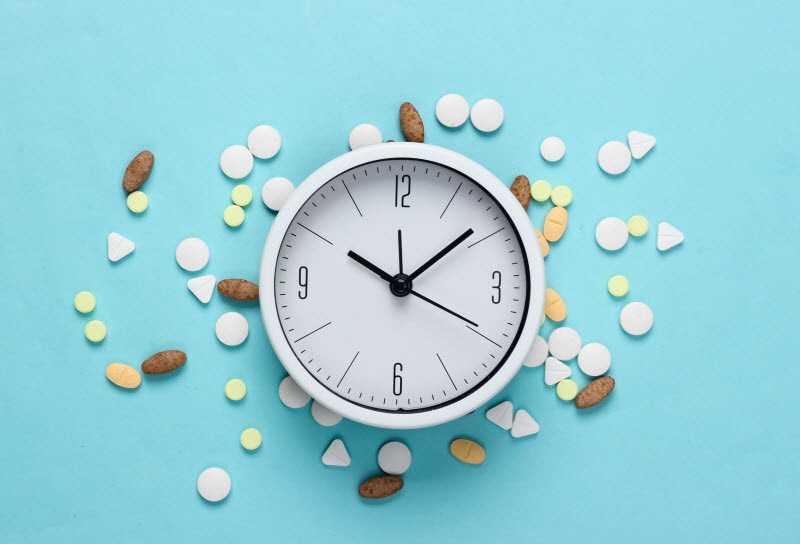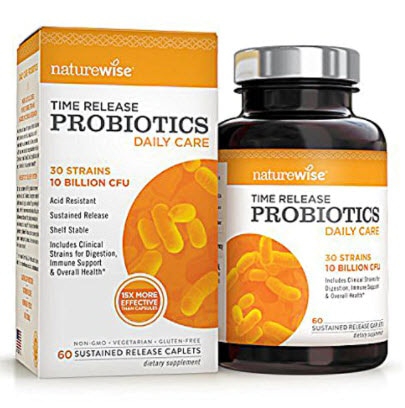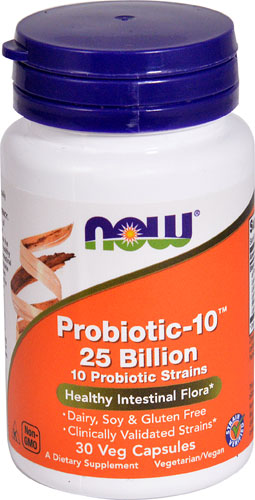[vc_row][vc_column][vc_column_text]Can taking probiotics at a specific time maximize their benefits for
gut health? Is it possible to lose those benefits—or even
experience side effects—by taking them at the
wrong time?
There are several opinions on proper probiotic timing, and the “best” time may differ depending on the types of organisms or strains. To clear up the confusion, let’s take a look at some of the most common questions about when to take
probiotic supplements.

Should you take probiotics on an empty stomach?
Your stomach has a pH between 1 and 3 when empty, which is highly acidic. This environment can affect how many probiotic organisms arrive in your intestines alive. If the majority of them die off during digestion, your supplement won’t deliver the gut health benefits you were expecting.
Some
research shows taking a probiotic supplement either 30 minutes before or at the start of a meal maximizes microbial survival rates. This may be due to the rise in pH that occurs when you eat. Less acid means
more bacteria can
pass through the stomach unaffected. Eating some healthy fat with your meal, such as nuts or avocados, may also help the organisms pass safely through your stomach..
The only strain that doesn’t seem to require food is
Saccharomyces boulardii. This beneficial yeast appears to be able to survive the stomach’s acidity without the aid of a meal.
Are enteric coated probiotics a better choice?

To bypass the problem of stomach acid altogether, some probiotic supplements are made with enteric coatings. This type of coating doesn’t dissolve until after the pill leaves the stomach and reaches the more alkaline environment of the small intestine.
Enteric coatings can be beneficial if you’re taking less-common probiotic strains, some of which only have a
40% survival rate without additional protection. However, probiotics like
Lactobacillus, Bifidobacterium and Streptococcus appear to survive well throughout the digestive tract and don’t require enteric coating to be effective.
There is also a debate over whether probiotic strains can survive exposure to bile salts once the enteric coating dissolves in the small intestine, but research shows certain strains may be able to interact with bile salts in a way that
improves their viability.
Is it safe to take probiotics with antibiotics?
A review of scientific evidence suggests the practice of taking probiotics during a course of antibiotics
can reduce diarrhea. Researchers haven’t yet determined which strains are best for controlling this common side effect, but that doesn’t mean probiotics won’t help your gut when you’re on medication. You just might have to pay a little more attention to timing.
It’s safe to start taking a probiotic supplement as soon as you begin an antibiotic regimen. Space the doses a couple of hours apart to prevent the antibiotic from interfering with the probiotic’s ability to survive..
Be cautious about how long you continue to take probiotics when your antibiotics are gone. One study indicated that four weeks of supplementing can
delay microbiome recovery for several months. The study only tested one probiotic preparation containing 11 strains, so it’s possible that a more targeted, personalized approach could have different results.
To be safe, limit probiotic intake to a one- to two-week period after taking antibiotics, and then take a break to let your microbiome finish repopulating naturally.
When should you take probiotics?
Although there isn’t yet a solid scientific answer on the “best” time to take probiotics, you don’t have to try to figure it out on your own. Manufacturers provide dosage and timing instructions specific to the strain or strains in the supplement.
When you’re using probiotics for general gut health,
consistency is important. Use the manufacturer’s instructions as a guide for best results as you make probiotic supplements part of your routine.
If you don’t see the results you want, the bacterial strain is more likely to be the culprit than timing. Probiotics are complex, and factors like
strain type, combination and concentration can influence effectiveness. A knowledgeable healthcare practitioner can help you find supplements with strains specific to the health outcomes you’re seeking.
Feel free to experiment with probiotic timing until you find a schedule that works for you!
[/vc_column_text][/vc_column][/vc_row][vc_row][vc_column][vc_text_separator title="Featured Products" border_width="2"][vc_row_inner equal_height="yes" content_placement="middle" gap="35"][vc_column_inner width="1/3"][vc_single_image image="167750" img_size="full" alignment="center" onclick="custom_link" img_link_target="_blank" css=".vc_custom_1689352338364{padding-right: 7% !important;padding-left: 7% !important;}" link="https://www.vitacost.com/natures-way-fortify-optima-daily-probiotic-50-billion-live-cultures"][/vc_column_inner][vc_column_inner width="1/3"][vc_single_image image="167748" img_size="full" alignment="center" onclick="custom_link" img_link_target="_blank" css=".vc_custom_1689352356079{padding-right: 7% !important;padding-left: 7% !important;}" link="https://www.vitacost.com/vitacost-probiotic-15-35-15-strains-35-billion-cfu-per-serving-60-vegetarian-capsules"][/vc_column_inner][vc_column_inner width="1/3"][vc_single_image image="167749" img_size="full" alignment="center" onclick="custom_link" img_link_target="_blank" css=".vc_custom_1689352378811{padding-right: 7% !important;padding-left: 7% !important;}" link="https://www.vitacost.com/garden-of-life-raw-probiotics-women"][/vc_column_inner][/vc_row_inner][/vc_column][/vc_row]
 To bypass the problem of stomach acid altogether, some probiotic supplements are made with enteric coatings. This type of coating doesn’t dissolve until after the pill leaves the stomach and reaches the more alkaline environment of the small intestine.
Enteric coatings can be beneficial if you’re taking less-common probiotic strains, some of which only have a 40% survival rate without additional protection. However, probiotics like Lactobacillus, Bifidobacterium and Streptococcus appear to survive well throughout the digestive tract and don’t require enteric coating to be effective.
There is also a debate over whether probiotic strains can survive exposure to bile salts once the enteric coating dissolves in the small intestine, but research shows certain strains may be able to interact with bile salts in a way that improves their viability.
To bypass the problem of stomach acid altogether, some probiotic supplements are made with enteric coatings. This type of coating doesn’t dissolve until after the pill leaves the stomach and reaches the more alkaline environment of the small intestine.
Enteric coatings can be beneficial if you’re taking less-common probiotic strains, some of which only have a 40% survival rate without additional protection. However, probiotics like Lactobacillus, Bifidobacterium and Streptococcus appear to survive well throughout the digestive tract and don’t require enteric coating to be effective.
There is also a debate over whether probiotic strains can survive exposure to bile salts once the enteric coating dissolves in the small intestine, but research shows certain strains may be able to interact with bile salts in a way that improves their viability.




